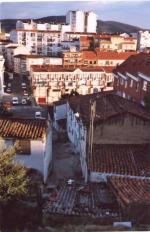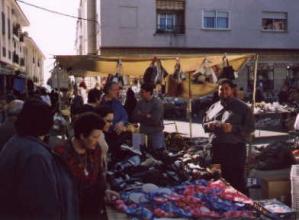

|
The Gypsies, the Spanish revivalAmong the peoples of Spain, one group stands out as different, although in many ways their culture impregnates all that is regarded as "typical" of Spain. The Roma, better know as the Gypsies, are regarded with distrust by most Spaniards, being associated with petty crime, blood feuds and the worst of Spain's image abroad, as well as with the flamenco song and dance made famous in recent years by Joaquín Cortés. Dark skin, hair and eyes (but Penelope Cruz is not a gypsy), together with very different dress and lifestyle, mark out these colourful semi nomads, who nowadays largely live in ordinary homes or ramshackle makeshift dwellings rather than the caravans known elsewhere in Europe. The Spanish gypsies are also among the only Roma in Europe to have almost completely adopted the national language, Castillian, to speak at home.During the 1970s a very interesting phenomenon occured among the gypsies of southern France, Spain and Portugal. In the south of France some gypsies came to Christ, were thoroughly converted and the Gospel began to spread like wildfire among them. So much so that a large part of the gypsy population are now born again and virtually none have not heard the Gospel. It became rapidly clear that they did not fit naturally in traditional evangelical churches, since they have such a different style of being, very exhuberant in expression and worship. A new denomination soon became established, the Filadelfia church. Among the earliest pastors there was great commitment, but hardly any of them could read and write. This evidently gave rise to excesses and difficulties relating to knowledge of the Word of God, which have taken time to correct, although many Spaniards and others have volunteered help in literacy and Bible knowledge. The majority of believing gypsies have turned from their own ways, although for some the habits of a lifetime take long to adapt completely. But most continue in a semi-nomadic or at least outdoor lifestyle and can be found on many of the open air market stands in towns and villages across the length and breadth of the land. It is a joy to go into some "unevangelised" village on market day and find up to forty believers among the stall holders.Nevertheless, while among their own the Spanish gypsies work hard to preach the Gospel, they have had difficulty in communicating it to Spaniards who have always distrusted them and therefore had little to do with them if at all possible. We need to pray that the Spanish gypsies would be able to grow in the knowledge of God's Word and also that they would be used by God to reach out to the Spaniards around them. New book about the Gypsy revival21 October 2004. A book has just been published on this subject, “Gitanos Pentecostales”, by Editorial Signatura, written by a teacher at Seville University, Manuela Cantón She concludes "se suele ver con mucha suspicacia este tipo de religiones y se las equipara a movimientos sectarios", a lo que agregó que, "después de 13 años estudiando la Iglesias pentecostales por países latinoamericanos, he comprobado que aquellos que acceden a ella lo hacen libremente y teniendo las ideas bastante claras". "This kind of religious group tends to be regarded with great suspicion and considered sectarian, but after 13 years studying the Pentecostal Churches in Latin America I have demonstrated that those who join them do so freely and with reasonable understanding." She also concludes that the Gypsy revival has removed much of the delinquent behaviour of those who have joined the Filadelfia Church. Romanian RomaIn recent years, the arrival of non-evangelical Romanian gypsies has much confused the panorama of growing acceptance of the Spanish Roma. The Romanians are typical of what the Spanish gypsies were 30 or more years ago. As the Spanish no longer speak Romany, it is also hard for them to evangelise these new-comers. Source: Protestante Digital at this link |

